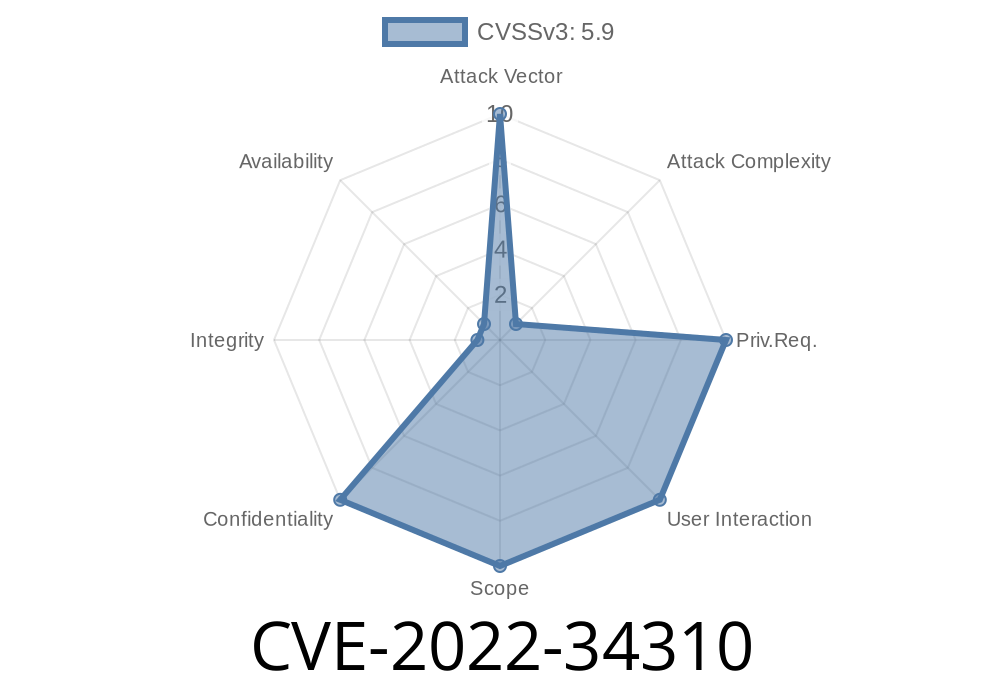Cybersecurity is full of complex terms, but sometimes the risks can be surprisingly simple. That’s the case with CVE-2022-34310, a vulnerability in IBM CICS TX Standard and Advanced 11.1 where the software uses weak cryptography. Let’s break down what this means, how it can be exploited, and what you can do if you’re affected.
What Is IBM CICS TX?
IBM CICS TX (Transaction Server) is software used by organizations to manage and scale important financial or transactional work—think banks, retailers, and insurance companies. Version 11.1 is widely deployed, which is why any vulnerability here deserves special attention.
About the Vulnerability
CVE-2022-34310 (IBM X-Force ID: 229441) exposes IBM CICS TX 11.1 to a risk where the application uses cryptographic algorithms that are “weaker than expected.” This means that data encrypted by CICS TX might not be protected as securely as users think. An attacker could potentially decrypt sensitive information—like financial transactions, customer records, or internal communications—if they intercept the encrypted traffic or get access to stored data.
Official references
- IBM Security Bulletin
- NVD Entry
- X-Force Exchange Report
Breaking Down the Problem
IBM CICS TX 11.1 relied on cryptographic algorithms that weren’t good enough by modern standards. This could include outdated techniques like 3DES (“Triple DES”), RC4, or weak ciphers/primitives with short keys or poor random number generation. Attackers with enough motivation and resources can break these algorithms far more easily than today’s secure standards like AES-256 and TLS 1.3.
How might this be exploited? Let’s imagine a scenario
1. Eavesdropping: A hacker positions themselves on the same network as the CICS TX server and a client.
Capturing Data: They record encrypted communication traffic between the two.
3. Decrypting with a Known Weak Cipher: Because the data was encrypted with an algorithm like 3DES (which is much easier to crack than modern ciphers), the attacker runs open-source tools to brute-force or cryptoanalyse the communication.
Sample Code: Cracking 3DES Encryption
Suppose sensitive CICS TX config files or traffic are encrypted using 3DES with a known weak key. Here’s a super simplified Python script (using pycryptodome) that demonstrates decrypting 3DES-encrypted data—for educational purposes only:
from Crypto.Cipher import DES3
key = b'Sixteen byte key' # Example of a weak/bad key
iv = b'12345678' # 8 byte initialization vector (IV)
ciphertext = b'\x13\xf\x1f\\\xd5\xdb\x22...' # Encrypted bytes
cipher = DES3.new(key, DES3.MODE_CBC, iv)
plaintext = cipher.decrypt(ciphertext)
# Remove padding if necessary
plaintext = plaintext.rstrip(b'\x00')
print("Decrypted:", plaintext.decode('utf-8', errors='ignore'))
If the key or the algorithm is weak, a hacker could try all possible keys (brute force) or use known cryptanalytic attacks, and it wouldn’t take long to get the plaintext.
Real Impact
What’s at risk?
Compliance risks (violating GDPR, HIPAA, PCI DSS, etc.)
This is why weak cryptography isn’t an abstract risk. Attackers today have easy access to cloud power and open-source tools to break legacy encryption.
What Has IBM Done?
IBM has released a fix which strengthens cryptography in CICS TX 11.1, typically by requiring stronger ciphers and disabling legacy protocols.
Update immediately: Check IBM’s security bulletin and apply all patches.
- Audit encryption settings: Force the use of strong protocols (like enforcing TLS 1.2+), disable 3DES, RC4, or any legacy ciphers in your config.
Here’s a secure example of TLS cipher suite settings for a server
# Example for Apache httpd or similar
SSLProtocol all -SSLv2 -SSLv3 -TLSv1 -TLSv1.1
SSLCipherSuite HIGH:!aNULL:!MD5:!3DES
SSLHonorCipherOrder on
Conclusion
CVE-2022-34310 isn’t about a “zero-click” hack or fancy malware. It’s a reminder that the foundations—like good cryptography—matter most. If you’re running IBM CICS TX 11.1, you must act fast: upgrade, audit, and enforce strong encryption everywhere. Don’t let weak ciphers undermine years of hard work on data protection.
More Reading
- IBM’s Official Bulletin
- NVD CVE Page
- CryptoFail - Common Crypto Mistakes
Disclaimer: This post is for educational and awareness purposes only. Always follow ethical guidelines and law.
Timeline
Published on: 02/12/2024 18:15:07 UTC
Last modified on: 02/12/2024 20:39:15 UTC
